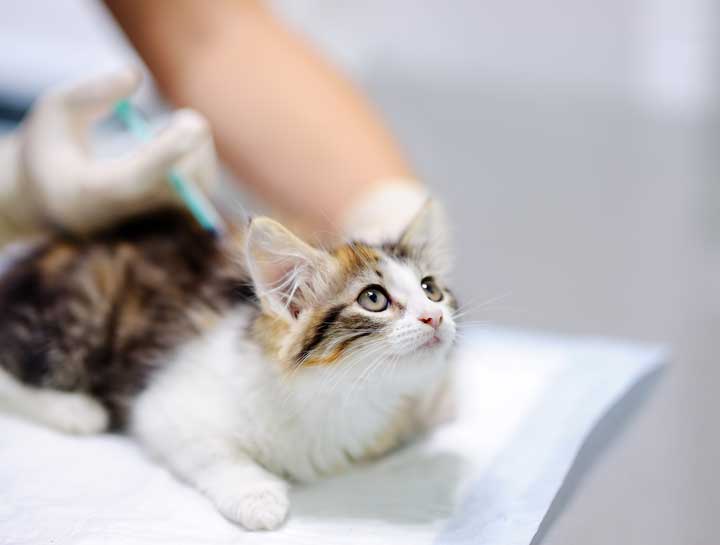Why Vaccines Are Important – Cat Edition

ON THIS PAGE:
- Core vs. Non-Core Vaccines
- Feline Herpes Virus
- Feline Calicivirus
- Feline Panleukopenia
- Feline Rabies
- Feline Leukemia
You’re taking a trip to the veterinarian’s office for your cat’s annual vaccines. This is a time to get any questions you may have about your kitty’s health answered. But sometimes, there are questions you just don’t think to ask. Like, what are all those abbreviations on your invoice, such as FVRCP? And, for that matter, what are those diseases you’re protecting your pet against, and what would happen if your cat contracted them?
The vaccines your veterinarian recommends consist of a combination of core and non-core vaccines. Veterinarians in one state may recommend non-core vaccines that pets in another location may not need. Doctors recommend non-core vaccines based on the risk of a specific disease in a geographical area, your pet’s activities and lifestyle, and any underlying health conditions.
For example, a strictly indoor cat may not need all the vaccines that an outdoor cat would. And a dog that competes in agility or other types of activities where they are around a lot of dogs may need additional vaccines—more than another dog that never leaves their home. (Be sure to read the Dog Edition of this blog!)
So what are the differences between core and non-core vaccines? How often do pets need these vaccines? What are the symptoms of each disease they vaccinate against, and how could a pet contract them?
Core vs. Non-Core Vaccines
Simply put, a core vaccine is one considered vital to the health of your pet and is recommended for all pets, regardless of lifestyle or where they live. According to the American Animal Hospital Association (AAHA), the core vaccines for cats are feline calicivirus, feline herpesvirus (also known as rhinotracheitis), feline panleukopenia, feline leukemia, and rabies.
Non-core vaccines protect against illnesses that are considered less life-threatening than those covered by core vaccines, but these diseases can still cause serious symptoms that are costly to treat, and can even be deadly. Non-core vaccines are given depending on your pet’s exposure risk. Because these factors can change over time, it’s good to discuss with your veterinarian any changes to your pet’s lifestyle at each wellness visit.
Note that, just like with human vaccines, no vaccines protect 100% of pets 100% of the time, as there are many different strains of diseases. But vaccines are still very highly effective and offer the best protection for your pet.
Further, having a low occurrence of a certain disease in your area doesn’t necessarily mean that the disease is rare and your pet doesn’t need to be vaccinated. It more likely means that most cats in the area are vaccinated and therefore are much less likely to contract it. In other words, the vaccines are doing their job in those vaccinated pets.
The FVRCP combines three core vaccines and is a crucial part of your cat’s health care routine. It prevents three potentially deadly airborne viruses: rhinotracheitis, calicivirus, and panleukopenia. Core vaccines in felines (except for the rabies vaccine, which is given in one dose) are given in a series of boosters as kittens. Adults receive boosters as recommended by their veterinarian.
Feline Herpes Virus (FHV), AKA the “R” in FVRCP
Feline herpes is highly contagious to other cats and can cause many symptoms and secondary infections, including upper respiratory infections and conjunctivitis. One of those respiratory infections is rhinotracheitis, the “R” in FVRCP.
Symptoms can last many weeks, or cats can be asymptomatic for many years, only presenting when the cat is stressed or ill. They include fever, coughing, sneezing, eye, and nose discharge, throat pain, drooling, loss of appetite, lethargy, and pink or swollen eyes. Ulceration of the cornea can occur also. Occasionally, FHV can inflame the skin as well, causing ulcers around the nose and mouth area and down the fronts of the legs.
The virus will continue to shed for around three weeks, making it contagious to other cats through direct contact, sharing feeding bowls, litter boxes, bedding, and toys, or inhalation of respiratory droplets. FHV can only survive 1-2 days on surfaces and the environment.
Typically, FHV diagnosis is made through clinical examination. Antiviral medications are used in treatment, as are antibiotics when secondary infections occur. Hospitalization may be required for severe cases.
There is no cure for FHV, and even cats that have recovered from symptoms will continue to carry the virus for life. Unlike other illnesses, however, carriers do not necessarily shed the virus at all times. Stress should be minimized for FHV-infected cats to avoid relapse. Vaccination does not prevent a cat from contracting the virus, but it does keep symptoms from becoming as severe as those in an unvaccinated cat.
Feline Calicivirus (FCV), the “C” in FVRCP
Feline calicivirus is a virus that attacks the respiratory system, the musculoskeletal system, and the intestines and causes ulceration of the mouth. Common among cats and highly contagious, this virus is easily passed through direct contact or sharing feeding bowls, litter boxes, bedding, and toys, as well as through inhalation of respiratory droplets.
FCV can survive weeks on surfaces and the environment. Symptoms can present themselves within 2 days to 2 weeks after exposure and include eye and nose discharge, painful ulcers in the mouth resulting in drooling, squinting or excessive blinking, loss of appetite, lethargy, fever, and joint inflammation that makes walking difficult. Cats may be ill for up to 6 weeks and shed the virus for 3-4 weeks after recovery.
Often, the presence of mouth ulcers and other clinical signs is enough for a veterinarian to make a diagnosis, though there are diagnostic tests that can provide a definitive diagnosis. Treating FCV can involve managing symptoms and secondary infections with antibiotics, but hospitalization may be needed for more severe infections.
A cat can have asymptomatic FCV and be a long-term carrier of the virus.
Feline Panleukopenia (FPV), the “P” in FVRCP
FPV—also known as feline distemper or feline parvo—showed a promising steep decline in numbers when the vaccine was first implemented, but the numbers of FPV have started to climb again in recent years. FPV infects and kills off cells in the body, such as those found in the lymph nodes, intestines, and bone marrow, and in developing kittens in utero, making this highly contagious disease very deadly once contracted.
Symptoms include fever, lethargy, loss of appetite, lack of thirst, vomiting, diarrhea, and dehydration. Low blood cell count can lead to anemia and secondary infections.
Cats shed the virus for 1 to 2 days through bodily fluids such as blood, urine, nasal secretions, and feces. Fleas that have bitten an infected cat can also transmit the virus. Once in contact with the cat’s environment, the virus can live up to a year and is resistant to disinfectants.
Humans can even transmit the disease from an infected cat to another cat if they have not washed their hands between contact. Isolating infected cats is crucial to stopping the spread of disease.
Diagnosis is compromised by the fact that FPV can resemble feline leukemia, immunodeficiency virus, pancreatitis, salmonella poisoning, and other types of poisoning. Bloodwork, urinalysis, and fecal exam may aid in diagnosing this disease.
Treatment includes supportive care, intravenous fluids, and antibiotics for secondary infections. After recovery, a cat will have lifetime immunity.
Feline Rabies
This core vaccine is administered in one dose and can be given as early as 12 weeks of age, depending on the state in which you live. Boosters can be every 1 year or 3 years, depending on the vaccine given. Rabies is virtually always fatal to cats—with no treatment available—so prevention is vital. Rabies is transmissible to humans, and it is also almost always fatal.
Rabies is typically transmitted through the bite of an infected animal, and on rarer occasions can be passed through a scratch of an infected animal. Rabies affects the central nervous system, including the spinal cord and brain. Symptoms include sudden personality change, aggression, excessive drooling (or foaming), difficulty swallowing, staggering, seizures, and paralysis.
Clinical diagnosis of rabies is only possible through a biopsy of brain tissue after death. Treatment depends on when the pet is brought to the vet. If your cat has been bitten by a wild animal, it’s important to contact your vet immediately, as a booster of the rabies vaccine can be administered to lessen the chance that your cat will contract the virus.
The vet will also clean the wound to prevent infection. It is possible to contract rabies through your cat’s wound, so disposable gloves are necessary when handling. The incubation of the virus is typically 3 to 8 weeks before signs develop, in which case it is too late to treat.
Feline Leukemia (FeLV)
Some veterinarians consider this a core vaccine, while others classify it as non-core and only recommend it for cats that go outside or have contact with other cats. FeLV weakens the
immune system, leaving the body susceptible to other diseases, including blood disorders and cancer. Cats may live for years without any symptoms, making this highly contagious virus easy to pass to other cats through saliva, blood, or by an infected mother passing it to her kittens.
Symptoms include fever, lethargy, loss of appetite, weight loss, diarrhea, breathing problems, pale gums, yellow coloring around the mouth, and yellowing of the whites of the eyes.
Diagnosis is made through blood tests. There is no cure for FeLV, but secondary infections are managed through supportive care and medications.
There are other non-core vaccines available, which are typically not given to cats, as the infection rate for the illnesses they vaccinate against is low, and the protection rate the vaccine provides can be even lower.
We hope we’ve answered your questions about cat vaccines, including those you didn’t know you had! The veterinarians at the Downtown St. Pete Vet Clinic are here to help you and your cat gets the protection your pets need to live longer and happier lives. Contact us at 727-755-7387.
